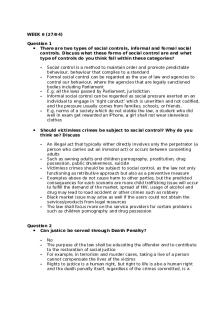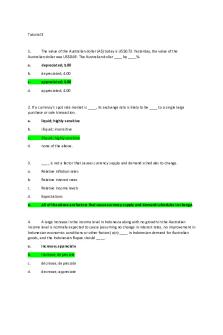Tutorial 3 PDF

| Title | Tutorial 3 |
|---|---|
| Course | Business Development with Information Systems |
| Institution | Aarhus Universitet |
| Pages | 4 |
| File Size | 126.7 KB |
| File Type | |
| Total Downloads | 96 |
| Total Views | 171 |
Summary
Tutorial 3 questions answered...
Description
Questions to be prepared and discussed in class: 1. What is a process? A group of coordinated activities that lead towards a specific goal and transforms input to output. They are cross-functional and extend across many departments of the organization They can be decomposed into several tasks, also called sub-processes They are completed or not done at all (all or nothing) a. A process is a series of steps or tasks required to achieve a specific goal i. In organizations, everything that happens is based on a series of processes ii. Processes are not necessarily linear, several activities can take place at the same time
iii. Processes are completed or not done at all (all or nothing) iv. Processes can usually be decomposed into several tasks, also called subprocesses.
v. Processes typically extend across many organizational boundaries, they are cross-functional.
b. Allows to focus at the work that must be done to ensure optimal creation of value. i. Avoid or reduce duplicate work, facilitate cross-functional communication, optimize business processes, and best serve the customers and stakeholders.
c. A process is an interrelated, sequential set of activities and tasks that turn inputs into outputs.
d. A well defined process has: i. › a beginning and an end ii. › inputs and outputs iii. › a set of tasks (sub-processes or activities) that transform the inputs into outputs
iv. › a set of metrics for measuring effectiveness v. › a set of associated roles and responsibilities
2. What is Business Process Management?
Page 1 of 4
-
BPM is a management discipline that treats business processes as assets to be valued, designed and exploited in their own right
-
BPM is a structured approach employing methods, policies, metrics, management practices and software tools to manage and continuously optimize an organization's processes
-
BPM aims to improve agility and operational performance
-
BPM treats processes as organizational building blocks with as much (if not more) significance as functional areas and geographic territories
The process Management cycle
3. Explain the difference between effectiveness and efficiency and assess the terms, internal control and compliance (Belanger, Van Slyke, & Crossler, 2020, p. 275; Table 11.3). Efficiency - The relationship between output and input (amount of output per input) Minimize time Minimize cost Minimize use of resources Efficient: Performing or functioning with the least waste of time and effort Efficiency is associated with costs; power and energy; labour; and operations Effectiveness – The relationship between output and target (produce the output that supports the target) Support business strategies Allows execution of business processes Strengthen organisation structure and - culture Increase value for customers Effective: Adequate to accomplish a purpose; producing the intended or expected result Effectiveness is associated with meeting strategies and objectives
There are four key areas for business process improvement: › Effectiveness – does the process output contribute to achieve the objective? › Efficiency – how fast/cheap/resource minimizing can the process be executed? › Note. Definitions p. 273 and p. 282 only take time into account › Internal control – is it possible to change data by error or illegally during execution of the process?
Page 2 of 4
› Compliance – does the process comply with the regulatory or statutory obligations of the organization?
Effectiveness: The relationship between output and target (produce the output that supports the target) A process is effective if it delivers a product that matches our target
Efficiency: The relationship between output and input (amount of output per input) A process is efficient if resources are used in the most effective way and at the same time minimizes time, costs and resources.
Internal control: The extent to which the information and data used in the performance of process cannot be changed by error or illegally.
Compliance: The extent to which the process follows the regulatory or statutory obligations of the organization.
4. Explain the difference between incremental and radical changes. Business Process Improvement = incremental change Process as sequence of work activities Consistency as overall goal – focus on execution Business Process Reengineering = radical change Radical re-thinking of process design Defines process as ”cross-organizational end-to-end work that creates customer value” Processes flow across functional boundaries
Incremental change( business Process Improvement BPI) -
small incremental changes in one or more business processes
-
The goal is to increase efficiency
-
is often preferred by the employees
Radical change (Business Process Reengineering BPR)
Page 3 of 4
-
Radical changes in one or more business processes
-
the goal is to increase effectiveness
-
Is often not preferred by the employees
Business Process Management = combination of both approaches
”an integrated system for managing business performance by managing end-to-end business processes”
5. Explain the difference between automate, informate, and transform (Belanger et al., 2020, pp. 278-279). Levels of change can be categorized representing three different levels of changing. It is concerning the role IT plays in changing or supporting business processes Automate: First-order change- Using technologies to perform a process more efficiently Inform: Second-order change- Using technology to better inform people Transform: Third-order change- Fundamental redefinition of BP or how work is done
Three levels of change giving rise to increasing change in the process execution: Automate › Technology performs processes, often to increase efficiency Inform › Technology informs process actors or stakeholders Transform › Fundamental change of process, often to increase effectiveness
6. Explain the connection between the IS Strategy Triangle and BPM. Business Process Management is about process improvements and helps create alignment between the different strategies in the IS Strategy Triangle.
At the beginning there is no alignment in the triangle because something is wrong with one of the aspects so we try to fix the problem and then make sure that there is alignment in the triangle.
Page 4 of 4...
Similar Free PDFs

Tutorial 3
- 3 Pages

Tutorial 3
- 4 Pages

Tutorial 3
- 4 Pages

Tutorial 3
- 12 Pages

3 - tutorial
- 6 Pages

Tutorial 3
- 6 Pages

Tutorial 3
- 4 Pages

Tutorial 3 - Lecture notes 3
- 5 Pages

Tutorial 3 Answers
- 4 Pages

Tutorial 3 Solutions - EC202
- 4 Pages

Tutorial 3 Solution - investment
- 3 Pages

Tutorial 3 - ccc
- 1 Pages

Tutorial work - 1 - 3
- 31 Pages

Tutorial 3 - Answers
- 6 Pages

OD tutorial 3
- 5 Pages

DEL tutorial 3
- 2 Pages
Popular Institutions
- Tinajero National High School - Annex
- Politeknik Caltex Riau
- Yokohama City University
- SGT University
- University of Al-Qadisiyah
- Divine Word College of Vigan
- Techniek College Rotterdam
- Universidade de Santiago
- Universiti Teknologi MARA Cawangan Johor Kampus Pasir Gudang
- Poltekkes Kemenkes Yogyakarta
- Baguio City National High School
- Colegio san marcos
- preparatoria uno
- Centro de Bachillerato Tecnológico Industrial y de Servicios No. 107
- Dalian Maritime University
- Quang Trung Secondary School
- Colegio Tecnológico en Informática
- Corporación Regional de Educación Superior
- Grupo CEDVA
- Dar Al Uloom University
- Centro de Estudios Preuniversitarios de la Universidad Nacional de Ingeniería
- 上智大学
- Aakash International School, Nuna Majara
- San Felipe Neri Catholic School
- Kang Chiao International School - New Taipei City
- Misamis Occidental National High School
- Institución Educativa Escuela Normal Juan Ladrilleros
- Kolehiyo ng Pantukan
- Batanes State College
- Instituto Continental
- Sekolah Menengah Kejuruan Kesehatan Kaltara (Tarakan)
- Colegio de La Inmaculada Concepcion - Cebu